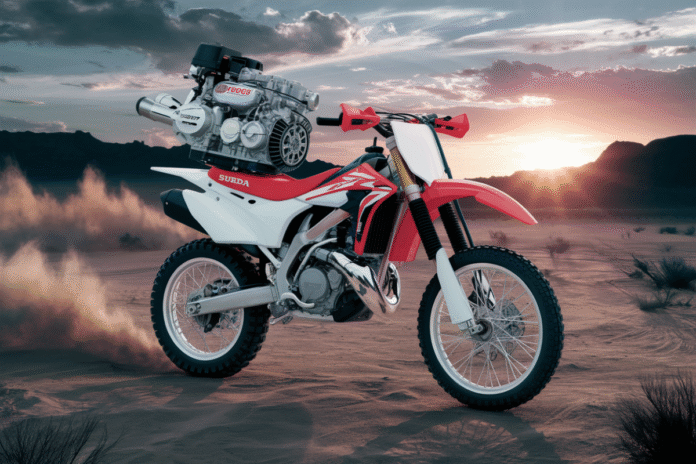“All bikes are enduro bikes if you have the skill,” claims Matt Spears, a statement that challenges conventional wisdom in the motorcycle community. The idea that any motorcycle can be transformed into an enduro bike with the right expertise and creativity opens up a world of possibilities for enthusiasts and riders alike. This perspective encourages a re-examination of what defines a motorcycle’s capabilities and invites riders to push the boundaries of their machines. As the conversation around motorcycle versatility grows, one must consider the implications of such modifications on performance, safety, and the rider’s experience.
The notion of transforming a standard motorcycle into an enduro bike raises critical questions about engineering, design, and rider skill. What if you could take the powerful engine of a Hayabusa and fit it into a Honda dirt bike frame? This radical idea not only blurs the lines between different motorcycle categories but also challenges the very essence of motorcycle riding. With advancements in technology and engineering, the potential for creating hybrid machines is greater than ever. However, this also brings forth concerns regarding safety, legality, and the practicalities of such transformations. As enthusiasts explore these innovative concepts, the motorcycle community must grapple with the balance between creativity and responsibility.
The Evolution of Motorcycle Design
Motorcycle design has undergone significant transformations over the years, driven by advancements in technology and changing consumer preferences. The traditional classifications of motorcycles—such as sport, cruiser, and dirt bikes—have evolved into more versatile machines that cater to a wider range of riding styles. This evolution has led to the emergence of hybrid models that combine features from different categories, allowing for greater adaptability and performance. As riders seek more from their machines, manufacturers are responding by creating bikes that can excel in various environments, from urban streets to rugged trails.
One notable trend in motorcycle design is the integration of powerful engines into lighter frames. For instance, the idea of fitting a Hayabusa engine, known for its remarkable speed and performance, into a dirt bike frame exemplifies this trend. Such a combination could result in a machine that offers both the agility of a dirt bike and the raw power of a sport bike. This fusion not only enhances performance but also challenges traditional notions of what a motorcycle can be, pushing the boundaries of design and engineering.
However, this evolution comes with its challenges. The integration of disparate components requires careful consideration of weight distribution, handling, and safety. Riders must also be aware of the legal implications of modifying their motorcycles, as certain changes may not comply with regulations. As the motorcycle industry continues to innovate, the balance between creativity and safety will play a crucial role in shaping the future of motorcycle design.
The Art of Customization
Customization has become a hallmark of motorcycle culture, allowing riders to personalize their machines to reflect their individuality and riding style. The ability to modify a motorcycle is not only a form of self-expression but also a way to enhance performance and functionality. Enthusiasts often take on the challenge of transforming their bikes into unique creations that stand out on the road or trail. This trend has given rise to a vibrant community of custom builders and modifiers who share their knowledge and skills with others.
One of the most intriguing aspects of customization is the potential for creating hybrid motorcycles. The concept of placing a Hayabusa engine in a Honda dirt bike frame is an extreme example of this trend. Such a transformation requires a deep understanding of mechanics and engineering, as well as a willingness to experiment with unconventional ideas. Riders who take on these projects often find themselves learning valuable skills and gaining a deeper appreciation for the intricacies of motorcycle design.
However, customization is not without its risks. Modifying a motorcycle can lead to unforeseen complications, including issues with handling, stability, and safety. Riders must ensure that their modifications do not compromise the integrity of the machine or their own safety. As the customization culture continues to thrive, it is essential for enthusiasts to approach their projects with caution and a commitment to responsible riding.
The Future of Motorcycle Riding
The future of motorcycle riding is poised for exciting developments as technology continues to advance and the lines between different types of bikes blur. As riders become more skilled and knowledgeable, the possibilities for customization and innovation expand. The idea that “all bikes are enduro bikes if you have the skill” resonates strongly in this context, encouraging riders to explore their creativity and push the limits of what their machines can achieve.
Emerging technologies, such as electric and hybrid powertrains, are also set to reshape the motorcycle landscape. These innovations promise to deliver enhanced performance while reducing environmental impact. The integration of smart technology into motorcycles will further enhance the riding experience, offering features such as navigation, connectivity, and advanced safety systems. As these trends continue to evolve, riders will have access to a new generation of motorcycles that cater to their diverse needs and preferences.
As the motorcycle community embraces change, it is essential to maintain a focus on safety and responsibility. Riders must remain aware of the implications of their modifications and the importance of adhering to regulations. By striking a balance between creativity and accountability, the future of motorcycle riding can be both thrilling and safe, paving the way for a new era of innovation and adventure.


